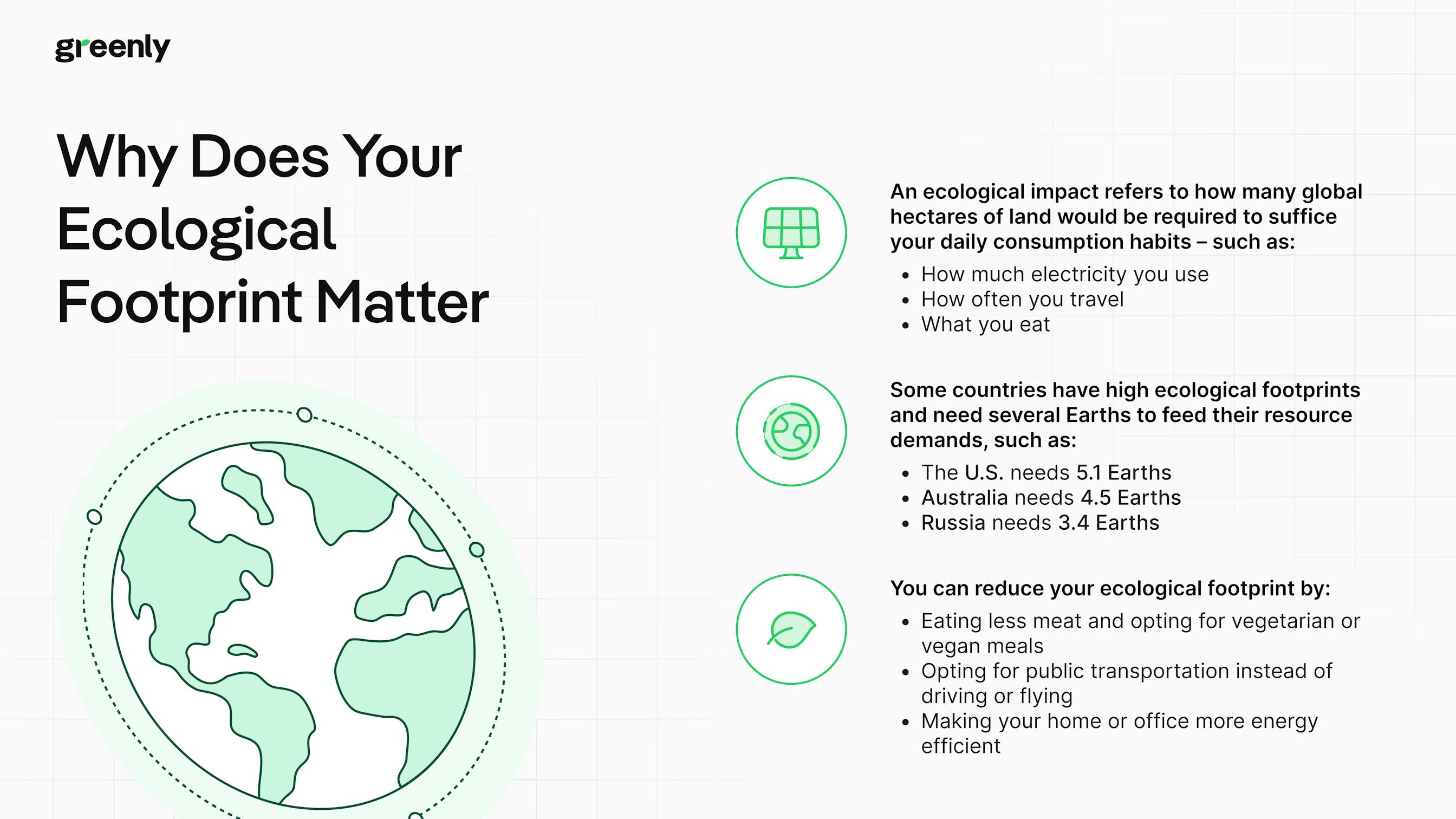ESG / CSR
Industries
Your Ecological Footprint: How to Calculate It & Why It Matters



It's true that most of our every day actions have an impact on the environment, and that one way or another – we all contribute to a global ecological footprint.
An "ecological footprint", refers to one's true ecological self-awareness – as many of our lifestyle and daily activities are far from being harmless for the planet.
The proof is in the pudding, as Earth overshoot day advances a little more each year. For example, on July 29, humanity consumed all the resources that the Earth is able to regenerate in one year as a result of the pressure that mankind exerts on the environment – such as with our increase in industrialization habits and excess consumerism.
In this article, we'll explain what an ecological footprint is, how it can be calculated, and the best ways to mitigate a poor ecological footprint.
What is an ecological footprint?
An ecological footprint refers to the ecological resources consumed by an individual person or community and how their carbon footprint, carbon dioxide production, and overall ecological footprint calculations have an impact on their surrounding environment.
💡 According to the Global Footprint Network, we are all able to grasp the ecological footprint concept by seeking to understand our impact on the environment, by measuring the amount of global hectares of biologically productive land needed to ensure our current resource consumption.


Here's everything you need to know about ecological footprints:
Ecological footprint definition
Therefore, an ecological footprint analysis can help us to better understand our unsustainable consumption of natural resources, our carbon footprints, ecological overshoot, the impact carbon emissions has on the human economy, and more.
👉 An ecological footprint determines the amount of raw materials consumed and the amount of harmful substances (such as waste generated, carbon dioxide emissions or greenhouse gasses) generated by human activities, which are then released into the atmosphere and contribute to humanity's total ecological footprint.
Calculating an ecological footprint has never been more imperative, as human beings continue to create deleterious ecological footprint measures on the entire planet.
The more we seek to engage with ecological footprint accounting, the more we can work to protect biologically productive area, avoid new, built up land area, protect fishing grounds, grazing land, capita consumption, and how many resources we consume on behalf of national footprint accounts.
💡 In short, the more we consume, the more resources we use and the more we pollute – such as by driving cars more frequently that contributes to an increase in air pollution or failing to protect our fragile water resources.
The environmental footprint is calculated in terms of the number of planets or land area (better referred to in ecological footprint accounting as global hectares). This works to determine how much space we need to support our current lifestyle.
This calculation can be done on an individual, national or planetary scale.
For example:
- It would take 1.7 planets to meet our current consumption habits;
- On average, a European needs the equivalent of 9 soccer fields (or 4.5 gha hectares) to meet their needs;
- On average, an American needs the equivalent 5.1 earths, or 8.1 gha hectares to meet their needs.
Here's a table to compare and contrast the amount of resources needed for countries to meet their needs on a global scale per global hectare and how many planets are required to suffice their particular lifestyle:
How many Earths would we need if everyone lived like U.S.A. residents?
| Country | Earths Needed | |
|---|---|---|
| U.S.A. | 5.1 | |
| Australia | 4.5 | |
| Russia | 3.4 | |
| Germany | 3.0 | |
| Japan | 2.9 | |
| Portugal | 2.9 | |
| France | 2.8 | |
| Spain | 2.8 | |
| Switzerland | 2.8 | |
| Italy | 2.7 | |
| U.K. | 2.6 | |
| China | 2.4 | |
| Brazil | 1.6 | |
| India | 0.8 | |
| World | 1.7 |
In the end, whichever way you cut it – we evidently over-exploiting the Earth's resources, to such an extent that nature has started to find it more and more difficult to regenerate itself.
👉 Even if it seems on the surface that there is no ray of hope in the midst of this gloomy picture, the truth is – we are all able to reverse these negative ecological footprint trends by changing our behavior.

What factors are used to calculate our ecological footprint?
Some of the factors used to calculate our ecological footprint include our food, our housing (in terms of surface and energy), our consumption of goods and services, or our modes of transport have an impact on the environment.
In other words, our daily life itself is likely to contribute to pollution – as we are not aware of the environmental impact of many of our choices. This being said, some activities still remain more harmful than others – such as the choice of our means of transportation, as this is still a sector around the world which continues to contribute to excess GHG emissions as it requires the use of fossil fuel.
💡 In short, an ecological footprint is the ratio between consumption and biocapacity (i.e. the earth’s ability to produce the resources we are demanding from it) – and it is calculated by measuring the things we eat, buy, and do in our daily lives.
What is the difference between an ecological footprint and a carbon footprint?
People often use the terms "ecological footprint" and "carbon footprint, but beware – the two terms are not one in the same, as a carbon footprint specifically refers to the carbon dioxide or greenhouse gas emissions emitted by an individual or nation, whereas an ecological footprint refers to the amount of land area needed to sustain the particular lifestyle of that region.
💡 In addition to this, be careful not to confuse carbon footprint and environmental footprint.
These two calculation methods have in common that they raise awareness of one's environmental impact (one's CO2 emissions, in particular), as well as the need to start a real energy transition.
Nevertheless, these two footprints do not reflect the same information:
- The carbon footprint is calculated in CO₂ and quantifies the GHG emissions of an individual, a population or an activity;
- The ecological footprint is calculated in surface area (global hectares or number of planets) and measures the surface area necessary for the consumption of an individual, a population or an activity.
Why should you calculate your environmental footprint?
The Global Footprint Network determines the exact date of Overshoot Day, based on the environmental footprint on a national and/or global scale.
In short, this is the date from which the planet's annual resources are exhausted.
👉 Remember, as of Overshoot Day – we also exceed the amount of greenhouse gas emissions that our ecosystem is able to naturally eliminate over the span of one, single year.

For several years, we have been talking about an ecological deficit, since our environmental impact exceeds the planet's available footprint and biocapacity. Even more alarming, this date comes earlier and earlier, as time goes by (July 28th, 2022, August 2nd, 2023, etc.). This means that from midsummer on, humanity is living on credit – the same way someone with a credit card but no money in their bank account continues purchasing things they can't actually afford.
Luckily, calculating our ecological footprint allows us to identify bad practices and fix them moving forward – and can help a brand to work on the development of a more sustainable business model as well. Ultimately, this can facilitate a greater pool or resources and wealth to share long-term.
Calculating your environmental footprint: benefits and estimation tools
To adopt sustainable behavior, it is important to take stock beforehand – meaning it is crucial to understand your personal footprint, how human enterprise contributes to waste production, and how humanity's demand (especially in densely populated areas) cannot keep up with the current land and water available.
💡 After all, how can you change your lifestyle, without knowing what further improvements can be made?
This is exactly why calculating your ecological footprint can help to better understand the difference between demand versus supply, and how many countries and the world are living in delusion – believing that the Earth has an infinite ability to conduct regenerative capacity behavior, when in reality – more carbon dioxide will do nothing but continue to raise our global footprints
Tools to calculate your environmental footprint
There are several environmental footprint calculators. These tools usually take the form of a questionnaire divided into several parts: food, place of living, modes of transport used, etc.
According to the answers provided, the tool determines the GHG emissions generated by these consumption habits, and then suggests some areas of improvement intended to promote the transition to a more ecological lifestyle.
Examples include the Global Footprint Network calculator, the ADEME calculator, and the WWF calculator.
👉 However, if we were to pick our favorite based on trying to calculate your personal ecological footprint – we would have to go with the Global Footprint Network Calculator. This is because the Global Footprint Network Calculator offers exceptional data quality as it allows for units in both square feet and square meters, miles and kilometers, and is user-friendly regardless of where you reside in the world.
5 ways to easily reduce your ecological footprint
Wondering about some of the ways you can reduce your negative impact on the environment?
Here are just a few of our eco-tips to help reduce your ecological footprint:
1. Optimize Your Travel
This first point is surely the most important, since it is one of the main contributors to the ecological footprint – as road trips and short haul flights continue to take the world by storm.
💡 Did you know that the transportation sector in the U.S. created 1.86 billion metric tons of carbon dioxide emissions in 2023 alone?
Unsurprisingly, airplanes and diesel (or gasoline) cars are the most polluting modes of transportation. In light of this observation, it is advisable to try to reduce your ecological footprint via transportation – such as by opting for cycling, walking and public transport (metro, bus or train) whenever available.
If it is impossible to leave the car in the garage, carpooling and the electric cars (EVs) are viable alternatives to limit CO₂ emissions.
👉 However, this doesn't mean that you need to give up carbon-intensive means of traveling, such as flying, altogether – seeing as some trips to distant countries leave no other alternatives. In this case, there is no need to kick ourselves for emitting a high carbon footprint, as it's easier than you think to compensate for the CO₂ emitted during this trip.
This can be done by simply observing the aspects of your daily life on which you could make valuable GHG savings, before and after your trip – in the same way you'll eat very little before going to a potluck party.

2. Moderate Your Energy Consumption
Here, the advantage is twofold: in addition to acting for the planet, you can cut back on your electricity bill by implementing energy efficiency!
This happens, first of all, by reducing the environmental impact of your heating and cooling.
💡 In fact, electric boilers and coal-powered energy emit 20 times more emissions in comparison to solar panels, photovoltaic installations or heat pumps. In addition, electric heating wastes 6 times more energy than a heat pump.
In order to reduce their energy consumption, homeowners can invest in the installation of new equipment, giving priority to the use of renewable energy. Tenants can send a letter to their landlord to request the installation of a green alternative and good thermal insulation.
On average, the unused rooms should be kept at a temperature of 15 to 18 °C to help saving on electricity consumption, with rooms constantly in use (such as the living room) should be heated to no more than 21 degrees.
Be sure not to leave water consumption out! Roughly speaking, the average American uses 82 gallons of water per day (washing machine, shower, toilet flush and dishwasher).
Therefore, it would be wise to use water wisely by not leaving the tap running when brushing your teeth, for example. This could mean taking showers instead of baths and not running the laundry machine or dishwasher half empty.

3. Recycle Your Waste
In the U.S., the average American wastes 4.9 pounds of garbage every day – when some, if not all of it, could be either recycled, upcycled, or composted
Our advice?
- Optimize recycling, to offer a second life to waste and avoid the extraction of new natural resources ;
- Use recycled materials;
- Buy less or second-hand – such as at a thrift store.
4. Try New Eating Habits
The average American eats 347.36 grams of meat everyday, and while meat isn't the worst thing on the planet – we've discovered that isn't the way to reducing your ecological footprint, either.
In order to reduce this rate, we need to rethink our consumption on an individual scale to avoid global food waste.
💡 A little tip: foods marked "best before" can be eaten a few days after the expiration date.
In the same way, consuming in a sustainable way implies the adoption of certain good practices:
- reducing meat consumption to adopt a flexitarian, vegetarian or even vegan diet;
- making it a priority to purchase organic, local and seasonal products, as well as short circuits, rather than imported products and prepared meals to be kept in the freezer.
5. Remaining Aware of Your Surrounds & The Rebound Effect
The rebound effect (also known as Jevons' paradox) is a particularly frustrating paradox.
There are two types: the direct effect and the indirect effect.
In the first case, the efforts made lead to disastrous results. This is the case, for example, when we over consume an alternative initially considered better than the initial solution – such as when someone eats more of a low-calorie snack because they are lower in fat to begin with, when in reality – you're consuming the same amount, if not more, of calories.
💡 The most popular ecological example is the use of LED bulbs, as their low environmental impact intrigues consumers to leave them on for long periods of time. The result is that this neglect negates all the efforts made, causing an even more negative impact than the original problem.
In the second case (the indirect rebound effect), a series of good practices is adopted, the results of which are then completely canceled out by a given action. For example, this may happen when you make good efforts on your daily energy consumption, only until you buy a brand new diesel car.
👉 Therefore, it is crucial to remain mindful every step of the journey to reduce your ecological impact and to be critical of all of your actions.
Overall, there are many ways to get started in reducing your ecological footprint – and it could not only help you to live a more sustainable, fulfilling life – but the planet, too.
What About Greenly?
If reading this article about ecological footprint has made you interested in reducing your carbon emissions to further fight against climate change – Greenly can help you!
At Greenly we can help you to assess your company’s carbon footprint, and then give you the tools you need to cut down on emissions. We offer a free demo for you to better understand our platform and all that it has to offer – including assistance with boosting supplier engagement, personalized assistance, and new ways to involve your employees.
Click here to learn more about Greenly and how we can help you reduce your carbon footprint.



